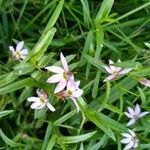A glabrous, branched, caespitose or prostrate rooting herb; stem 5-15 cm, terete, with two longitudinal ridges. Leaves alternate (distichous) with decurrent sessile or subsessile base, elliptic-ovate or lanceolate (especially apically), 13-33 by 2-6 mm; acute or blunt, subentire to shallowly toothed towards the apex. Flowers axillary, 7-15 mm, on one stem mostly 1-2, only one opened at a time. Pedicels terete, 6-37 mm, erect, ebrac-teolate. Calyx lobes narrow-triangular, 1.5-3 by 0.5-0.75 mm, dentate at the base. Corolla 5-12 mm, white to pale-purple (red in China), outside glabrous, inside hairy, sometimes with 2 green gibbosities, slit to the base; dorsal lobes connate with the lateral ones for 4-4.5 mm, lateral lobes connate with the ventral one for 4.5-6 mm; dorsal lobes 4.5-8 mm, linear, sometimes, reflexed, blunt, lateral and ventral lobes 3-6 mm, equal, linear to lanceolate, acute. Filaments 5-6 mm, for more than half-way free, all of equal width, the 2 anterior ones patent hairy, with a seta or hair tuft at the top; anthers from dorsal to ventral 2-1 mm, glabrous or hairy. Ovary 2-5 by 1 mm, trumpet-shaped, glabrous; style hairy at the base. Capsule on a recurved pedicel, 4-6 mm, obconical, glabrous. Seeds 3/8-0.5 mm, ellipsoid, somewhat compressed, dark-brown, smooth.
More
Herbs, perennial. Stems decumbent, slender, 6-30 cm tall, glabrous, lower nodes rooted. Leaves alternate, sessile or petiole to 1 mm; blade narrowly elliptic, elliptic, or lanceolate, 7-26 × 1.5-7 mm, glabrous, base rounded, obtuse, or broadly cuneate, margin entire or obviously serrate at upper part, apex acute or acuminate. Flowers usually solitary, axillary at upper leaves of branches; pedicels slender, 1.2-2.5(-3.5) cm; bracteoles 2 at base, ca. 1 mm, glabrous, or absent. Hypanthium narrowly obconical, base attenuate, not well distinguished from pedicel, 3-5 mm, glabrous; calyx lobes lanceolate, ± as long as tube, margin entire or with a pair of denticles. Corolla rose, white, or bluish, 10-15 mm, divided to base at back, white villous below throat; lobes all spreading in a plane on anterior side; lateral 2 lobes lanceolate or oblanceolate, longer than others, central 3 elliptic. Filament tube 6-8 mm, connate above middle, glabrous; anther tube 2-2.5 mm, back glabrous or sparsely villous. Capsule obconic, 6-7 mm. Seeds broadly elliptic, compressed, pitted. Fl. and fr. May-Oct.
On moist, grassy places, along watercourses and on cultivated land, on rice-fields and in tea and cinchona plantations, 500-1600 m, occasionally at lower altitudes. According to BACKER & VAN SLOOTEN no capsules with ripe seeds are found in Java. VAN STEENIS has found a plant at Bogor (n. 2151) with ripe capsules and seeds. I also saw a sheet in the Leyden Herb. (SCHIFFNER 2728, from Tjibodas) with ripe capsules and seeds. It remains questionable whether these seeds are viable.Propagation is normally vegetative. According to BACKER & VAN SLOOTEN it descends along water-courses to lower altitudes, even to the lowlands, by stolons or stems dispersed by water. However, such lowland habitats are only temporary.
More
Wet places, especially around paddy fields and in lowland all over Japan. Moist, grassy localities, along water courses and on cultivated land, like rice fields, tea and cinchona plantations, mainly between 500-1,600 metres.
Wet places, especially around paddy fields and in lowland all over Japan. Moist, grassy localities, along water courses and on cultivated land, like rice fields, tea and cinchona plantations, mainly between 500-1,600 metres.
Can be grown by cuttings or seedlings. Seeds needs stratification.

